The Richardson Family of Glenside
Memories of Catherine Richardson
These are the memories of Catherine Richardson who lived at the Halfway House in Glenside from her year of birth in 1944 until 1956, at the age of 12. Her brother Christopher and sister Frances also contributed to this local history. Scroll down for the article.

Catherine and Frances Richardson in the Halfway House garden, 1949. Photo: Allan Richardson
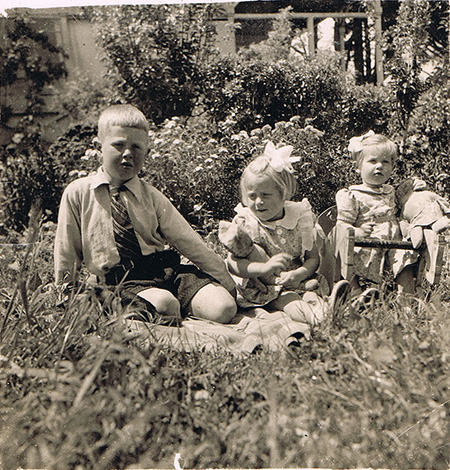
Peter, Catherine and Frances Richardson in the garden, Halfway House. Photo: Allan Richardson
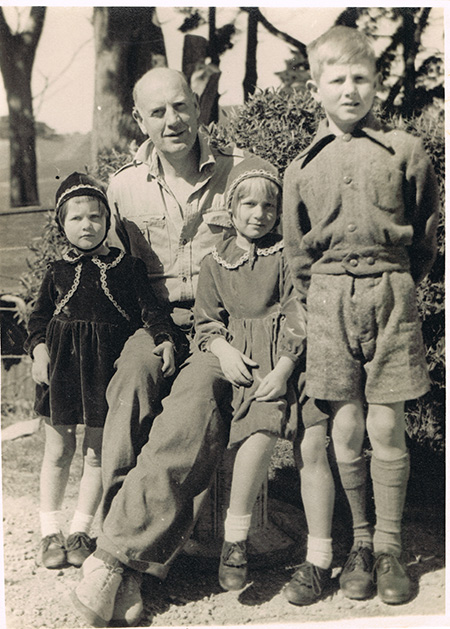
Allan Richardson and children Frances, Catherine and Peter, 1952. Photo: Kathleen Richardson

Catherine & Frances Richardson, 1928 Chevrolet Sedan, Halfway House. Photo: Allan Richardson
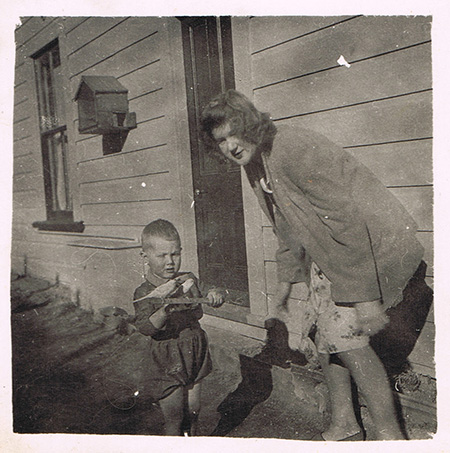
Peter and Betty Garry, Halfway House. Photo: Allan Richardson

Peter and Catherine with their toys. Photo: Allan Richardson
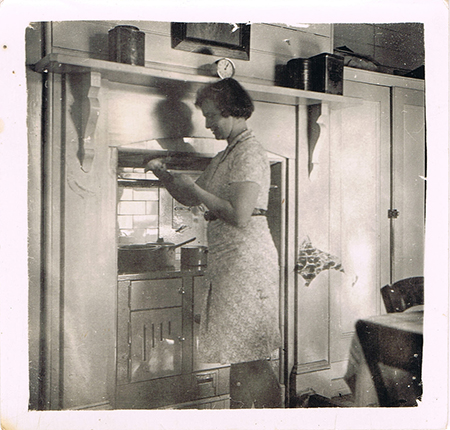
Kathleen Richardson. Interior of Halfway House. Photo: Allan Richardson
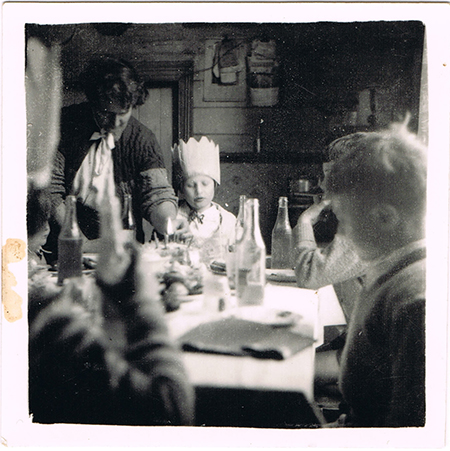
Lighting the candles. Birthday party, interior Halfway House. Photo: Allan Richardson
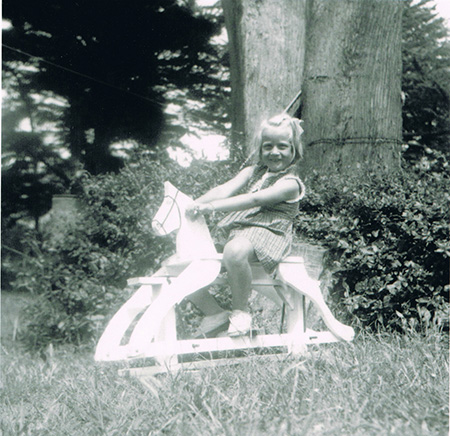
Catherine Richardson under the macrocarpa tree, Halfway House. Photo: Allan Richardson
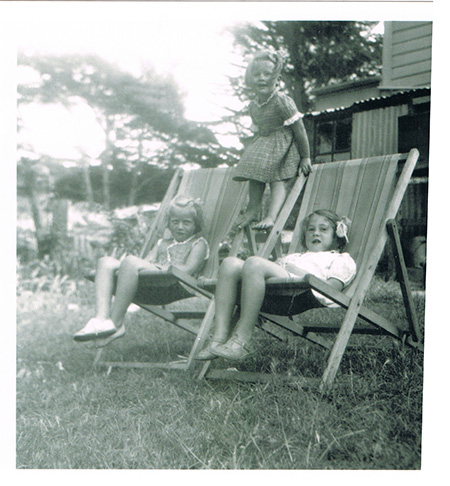
Fun and friends. Catherine, Frances and Priscilla Silvester. Photo: Allan Richardson
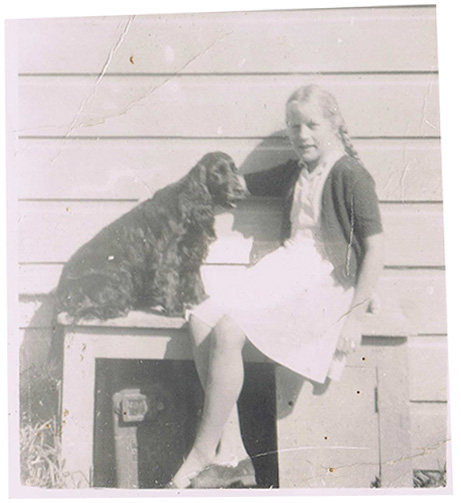
Catherine and the family's special pet, Tui, 1954. Photo: Allan Richardson
Introduction
My father, Allan Archibald Richardson, was the youngest of fourteen children and came from Mataura, near Gore, but was born and grew up in Pounawea in the Catlins. His father was from Newcastle-on-Tyne and mother from Scotland via Canada. My mother, Kathleen Paulin, who lived most of her early years in Central Otago, was one of six children, five girls and one boy. Her father descended from the French Hugenots, her mother of English/Irish extract. The family philosophy was that every girl should have at least a high school education, so my mother had an education. She spoke French fluently, without ever having left New Zealand at the time and was good at numeration. She did her general nurses training in Wanganui. It was in Wanganui that she married my father, who came up from Mataura with his sister, Tui who was witness to their marriage. Later my mother wanted to further her training and persuaded my father to go Porirua, where they both trained as registered psychiatric nurses.
Their first house was at the entrance to Porirua Hospital drive, under the macrocarpas, just past Linden if going North. My mother worked as a registered nurse then tutor sister, and my father was an attendant. The hospital was very productive then. It had its own farm which supplied everyone’s needs with the patients working providing produce for the hospital kitchens. They were busy and active and got to work with animals and grow vegetables.
The move to Glenside
My brother Christopher (Peter) was born in 1941 when my parents lived at Porirua, however when mother was pregnant with me, they needed to find a more suitable home, so came to live at Glenside, at the Halfway House. I was born in 1944 and my sister Frances in 1946.
The Halfway House
I always knew it as The Halfway House. It was always called that because it was halfway between Wellington and Porirua. Any other connotation was not known to me at that time. The house was situated up a lane shared with other neighbours.
The Webb's lived in the front of the house. Their access was from the front door and they had a kitchen and living room and upstairs the two front bedrooms and upstairs bathroom. We lived on the back half of the house and had the two back bedrooms. As there was no downstairs bathroom, we had to use the scullery and its big wooden tubs to bathe and wash. It wasn’t pleasant, but that was life and we didn’t know anything differently. There were engraved glass doors in the hallway separating the front and the back of the house. We had the back rooms of the upstairs as well. We children would put a pillow at the top of the stair bannister, sit on it, and fly down, yelling, nearly knocking off the newel post at the bottom, saying nothing of injuring our coccyx’s. The shared house concept worked well and there were no issues with the two families living together in the same big house. I don’t know how the ‘other side’ coped with the noise.
My sister and I shared the room that overlooked the big macrocarpa tree, which is now a stump on the eastern lawn. I remember that bedroom window very well as I cut my wrist on it. I was with Priscilla Silvester at the time. The lower sash window was broken. I put my hand through it to pull down the outer part which came down with a jerk and banged my wrist onto the broken lower part peeling back the skin exposing the bone! I showed Priscilla saying “Oh look, I can see the bone” and Priscilla paled but did not faint! As Mum was a nurse she bandaged it up and told me I shouldn't have been so silly. I have the scar to this day.
The verandah which Dad built on, on the west end of the house, became Peter’s bedroom. We had a much loved dog called Tui, a black Cocker Spaniel with a swishy long tail. She shadowed us everywhere. After the Webb’s, there was another family that moved in, the John’s.
The grounds
The grounds were separated for each family as well. The Webb’s had the front with the sloping bank and big lawn. We went outside our door onto the lane and turned left and as we went around the corner of the house there was a gate and a shell path beside a lilac bush that curved around to a hedge. We had gathered the shells from Titahi Bay beach and Makara. The hedge separated our part of the grounds from the front lawn. Our garden had flowers of iris, purple iris, gladioli, Livingstone daisies, hydrangeas and the American Pillar rose grew up the veranda post on the west side of the house. Further along the lane, toward the main road, was the shed where Dad kept the car and our big black chickens.
On the other side of the house, where the new orchard is, we had a lawn which was never mown. So, Dad was given a sheep which we called Nancy and had her tethered to a concrete grass roller. That way she could keep the grass down and not gallop off. No longer was this a wild overgrown area, it was just nibbled in patches with lots of sheep doo all around. Dad put some car cases along the poplars and these were our play huts.
There were cows on the other side of the fence and further across the paddock was a cow bale. We kids would wend our way across the paddock to the creek to watch eels, pick blackberries and catch cockabullies. The Taylor's, relatives of Priscilla’s family, from the corner on the main road also had a farm from where we would take our milk and every year, our cream for Christmas. On Christmas Day it was my job to go over and pick up the cream. I was running down the steep gravel driveway with my full billy and fell over, cutting my knees very well. Of course the cream spilled and I went home crying because of the blood and cuts. I had a good telling off for spilling the cream while I was being patched up. I still have those scars on my knees! There was a little cream left for the trifle.
Life at the Halfway
Mum and Dad worked opposite shifts, so in the morning, the parent at home would take us up to the hospital to meet the other parent coming off their shift. The shift started at seven o’çlock in the morning, so this meant we had to be up and dressed and in the car early for the shift handover. In winter we were bundled in with blankets, pillows and a hot-water bottle. I always remember this as Dad would listen to the morning radio, shining his shoes and we would always hear the radio at six o’clock with the pips and the comment which I can still hear today in that very ‘plummy’ voice “This is the BBC, London.”
Having the car was a great source of adventure. It was a big brown square right-hand drive 1928 Chevrolet Sedan. It had a grey/green velour interior, a huge steering wheel, and a running board (which we’d stand on while Dad drove it up the lane coming home, if he hadn’t taken his Indian motor bike) and little orange flags which flipped out when he hit a switch in front to indicate which direction we were turning. Mum had a James motor bike to use for work.
Dad used to make ginger beer with a bug. He had all the equipment, right down to the metal bottle topper to seal and press the lid onto the glass bottles. One day we were travelling with the ginger beer in the car, it was jiggling up and down and it was a hot day. Dad pulled over at Paekakariki and I sat on the running board of the car in my red coat waiting to have a drink. When Dad opened the bottle it exploded everywhere showering me with a sticky sweet mess. Loading us all up to go camping at Castle Point was another wild memory.
How Mum did all the activities she did at that time was mind blowing. She worked full time, baked, made all our clothes, crocheted beautiful tray cloths and table cloths, played tennis up at the Club at the top of Middleton Road, helped neighbours in need, played the piano, did my homework on occasion, had neighbours in and kept us three kids on a long long leash with Dad’s help.
Dad’s hobby was photography. He would often get on his motorbike and ride off with the camera. Mum told us of him going down to Ngauranga during the war as there had been talk of a Japanese submarine in the harbour and he wanted to see if he could capture it on film. He had the film confiscated as the authorities thought he was a spy.
Our birthday parties were marked with a noisy party in the kitchen with our friends sitting at the big wooden table, all of us wearing paper hats and stuffing ourselves with birthday goodies.
The neighbours
Priscilla Silvester was my very best friend. Priscilla lived on the main road, opposite our lane almost. Her mother Gwen (nee Rowell) whom we called “Aunty Gwen”, was no relation to us, she was a good friend of Mum’s. She and my mother played tennis up at the Johnsonville courts. I spent a lot of time at Priscilla’s place, or she sometimes came to mine. She was a brunette with long plaits and I was blond with long plaits. We wore ribbons on our hair and one boy sitting behind us in Johnsonville Main school once tied our ribbons together so that when we got up to leave our side of the desk we were jerked back nearly breaking our necks. He thought that was hilarious. I sometimes went home with the ends of my plaits coloured blue as he had put them in the ink well on his desk. Mum was not thrilled.
The family nearest us were the Farrell’s, who lived up the hill behind the Halfway House. This house was on the first corner up the hill but is no longer there. The Hughes lived on the main road next to our lane on the other side of the front fence. The Hughes children were Margaret, Shirleen, Donald and Caroline. Caroline was another best friend. Sadly Caroline passed away in 1982. Next to the Hughes lived the Glass-Johnsons, where the garden centre is now. When the Glass-Johnsons left, the Brown’s moved in.
The Narain’s had a farm on the hill up behind Stebbings Road. “Moxies” swimming hole was along the unsealed part of Stebbings Road where all the kids went for a dip, no adults in attendance. We’d jump off the rocks into the deep end. A dead cow or two may have been up the creek which we wouldn’t have thought about. If we smelt it we didn’t go in. Some of us had some sense.
If our hens weren’t laying we took eggs from the Hodges, on Stebbings Road. I remember Mr. Juliff who lived on the main road, whom Mum used to visit just to check up on him. He’s what I thought God would have looked like. He is buried at the cemetery on Kenepuru Drive.
The whole community met each November 5 for the Guy Fawkes bonfire on the corner of the main road (now Middleton Road) and Stebbings Road (the first part is now Glenside Road). It was great seeing all our friends rugged up, their faces shining, and laughing, as they let off their fireworks including Jumping Jacks, Sparklers and the odd rocket or two that I loved.
The Tulloch’s lived in the big house up the road [Ed. Where the Monterey Apartments are today.] Across from the Tulloch’s were the McNair’s and their children, Gillian, Elaine and David. [Ed. Now 219 Middleton Road]. Further up the road were the Garry’s, however we did not have to walk up the road to see them as a quicker way was to go behind Tulloch's. We would cross the stream that flowed in front of the house and walk up the hill [Ed. Where the large storage facility is today). The Perry’s lived up the hill beside the new motorway. [Ed. The old Braid cottage].
Shared telephone
We were on a party line and the telephone number was 48691. It was a shared line and managed by Mrs Ross at the Glenside Post Office. The Post Office is no longer operating and is now a private home north of the round-about on Middleton Road. If someone picked up the ‘phone while you were talking you would say ‘working’. I remember Betty Garry used to come over to use the phone to talk to her boyfriend. It was in the shared hallway and I would sneak up to the top stairs to listen to the conversation and think it was so boring.
Church
We went to St John Anglican Church in Johnsonville. Sunday school was held in the hall. All three of us were baptised on the same day 12 April 1953 by Minister Atkinson. He came to visit us at the house afterwards and after getting a bit tiddly Dad had to drive him home!
Playing in Glenside
Derailing trains
The Tangiwai disaster was fresh in our minds when we were young and I had heard that a train could be derailed by putting stones on the track. A group of us, Caroline, Priscilla and some others and I went down to the tunnel quite regularly. One day I put a stone on the track and waited for the train which I could see coming up the tunnel. I hid behind the tool box at the back of the workers’ shed, and whoosh suddenly it was here clattering out of the tunnel. The stone vanished and I was a bit worried that if the train came off the rails there wasn’t much room in the creek for the carriages to topple onto one another. I was very interested in how trains could be derailed! Fortunately it didn’t happen and I’ve never been a menace to NZ Rail. If I’d been born at another time I could have been an asset to the French Resistance.
Tennis on the main road
Now and again a small group of us would play tennis, on the Main Road. Fortunately not too many cars were around then. Some of the things we did were a little dangerous. I remember Dad bought some Japanese bayonets after the war and these were for us to play with.
Mushrooming
Mushrooming over the hills and far away was also something to do with the family, picking those lovely big ones with the brown skirts (Agaricus campestris, the field mushroom). They tasted rich and musky - I’ve never tasted mushrooms like that since.
Saving sheep
We used to spend a lot of time walking up the stream to the water tunnel which flowed under the motorway. We picked blackberries, rescued stranded sheep, and tried to save sacks of kittens that people threw into the stream to drown.
I remember one day we walked up to the water tunnel and found a sheep caught up on the barbed wire. I ran home to get some scissors to cut the wool free. Looking at it today, it doesn’t look very far but when I was a child, it was like 100 miles! I raced into the house and of course you can never find scissors when you need them, so I grabbed Mum’s prize pinking shears. I ran back up to the sheep and we cut its fleece free from the barbed wire. It bustled off to catch up with its sheep friends and I bustled back home with the shears and Mum was looking for them, so I sort of slipped them onto the bench. “Why are my shears on the bench?” She never knew and I have never forgotten the fear of getting caught!
The school bus
We used to catch the school bus to Johnsonville Main at the bridge. A little group of us would meet each frosty morning, it always seemed frosty, puffing out our steamy warm breath and stamping on icy puddles.
I remember sitting on the bus behind Mrs Hughes and she had this fox stole around her neck with the head hanging over her shoulder. The beady brown eyes of that dead fox were always staring at me. When I bought a beautiful antique, luscious chocolate coloured fox stole in the Brighton Lanes, England, in the 70’s, I thought of Mrs. Hughes.
Although we caught the bus to school, we walked home. We’d walk home with our school friends and I remember the McCrae’s, who lived up a farm drive at the young Wilson’s place. They would throw stones at our little group as we walked by. I wore a blue coat with my school bag across my chest. It wasn’t uncommon to pick up stones and throw them back. I remember the McCrae boy shouting out to “watch out for the little ….. in blue”. We all survived.
The Tulloch's
The Tulloch's lived in the big house nearby. Mr Tulloch was a well built, jovial, red-faced man. Mrs Tulloch was short, her hair was in a bun and she was always warm and friendly with a plate of biscuits at the ready. To get to the Tulloch’s house, we came in from the back of their property, as it was the quickest way to their house. Our mother and father visited them on occasion and we walked through a long covered concrete passage and entered the back door way. Firewood was stacked along the wall of the passage. We only ever went into the lounge. I was really curious about what was upstairs but was never allowed up there.
I loved the smell of that house, the smell of old sweet burnt wood. On each end of the mantelpiece were two beautiful identical porcelain sitting dogs. I was fascinated by them. They were stunning in their whiteness and smiling faces sitting up there so straight, looking forward.
The day Aunty Tui blew the house up
When the Army came to blow up the railway viaduct, we were all told to stay inside in our homes. My Aunty Tui had come up from the South Island to stay with us. She was a big woman, strong and capable, she used to cook for the shearers near Oamaru in the season. The house was full with visitors and we were all waiting for the blast, which was meant to take place at two o’clock that afternoon. Well, two o’clock came and went. Then it was two-thirty. We were tired of waiting. Aunty Tui got up briskly and said she would make the tea. Just as she put the plug into the socket there was a great “boom” and the house shook. She thought she had blown the house up! We rushed outside and there was a big black cloud rising from the viaduct which had just been blown. We kids were running around laughing and screaming. From that day forward, it was ‘the day that Aunty Tui blew the house up’!
The motorway had not opened at that time, early ‘50’s but I have a photo which my father took of me standing by an enormous wheel up there among the machinery during the works, you can hardly see me, only as a speck in a floral frock.
Leaving Glenside
In 1956 we left Glenside. I was not quite 12. We had a different dog by then, Spot. I hated leaving Priscilla and thought I’d never see her again nor ever, ever find another friend like her. That was the first separation experience that upset me. Priscilla and I are close now all these years later living not that far from each other on the Kapiti Coast.
Mum wanted to open a convalescent home in Paraparaumu, which she did on Manly Street. It was a three story place, and very well run by her and her registered nurses and helpers, including Dad, who retired not long after moving there. Dad had a long standing heart disease and it wasn’t the best move for him. He died four years later. That was the second separation experience that upset me.
Conclusion
My memories of growing up in Glenside will remain with me for the rest of my life. Often I dream of times living there with the hills and creek we used to explore, hear a song from the time, think of the people I grew up with and I thank God I had the parents I had and brother and sister I still have, the innocence of being young in post war NZ, things we grew up with, simple lives lived richly. Despite all the travel I’ve done in my life, my richest memories are those from my earliest childhood in Glenside, the friends we had, the mischief (adventures) we got up to, the love we had which wasn’t overtly shown but we presumed was there, and dreams I had then. Some came to fruition, some didn’t, but that’s all part of the big picture and it’s just fine.
I think my sense of ‘giving it a go’, independence and adventure came from the parents I had, and growing up down there in the valley among animals and kind caring people with character and a strong sense of community.
Catherine Richardson Jaubert, 2017
